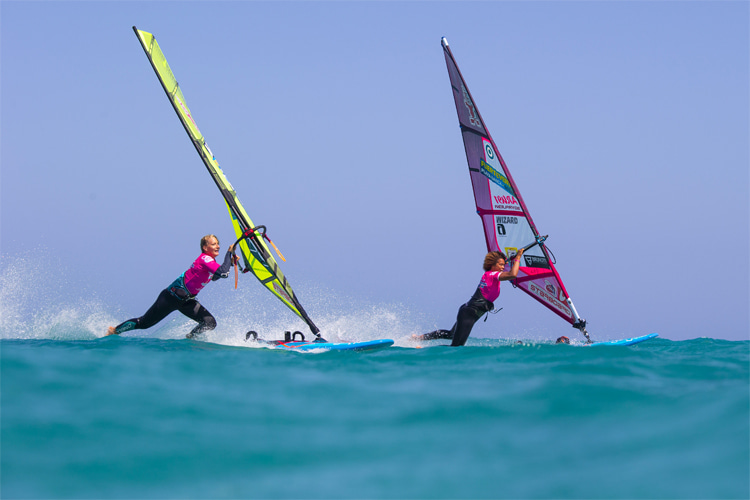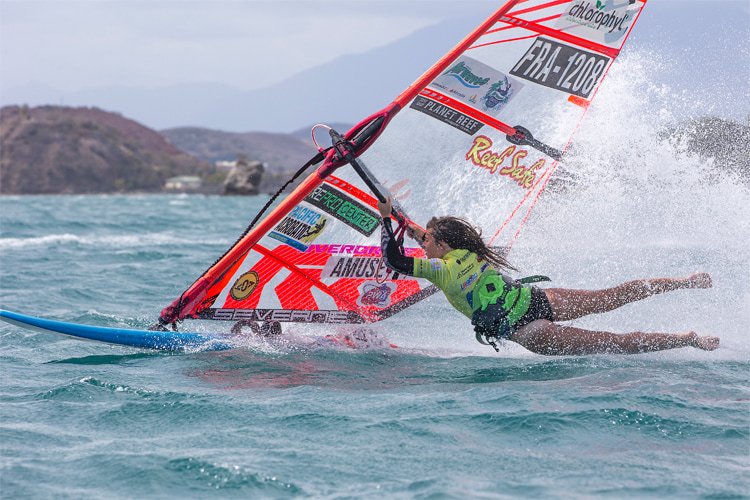Body dragging is a classic old-school move and one of the first techniques beginners learn when getting into freestyle windsurfing.
It's a stylish and feel-good maneuver that involves dragging your legs in the water next to the windsurf board before effortlessly jumping back onto it, still planing.
"It is easier to body drag on cambered sails," explains Michael Rossmeier, competitive windsurfer and author of the "Trickionary Windsurfing Bible."
"They have more constant power delivery and not an immediate off-switch - usually, the fear of catapulting causes you not to be lifted enough."
Although this timeless windsurf move is called a body drag, only the legs actually drag in the water - ideally, from the knees down to the toes.
Practice Jumping Onto the Board First
The hardest part of the move is getting back on the board.
Nevertheless, you can practice body dragging's final moment if you have access to knee-deep water and a sandy bottom.
In windy conditions, adopt a beach start position and start running with the board heading slightly upwind.
Then, extend the front arm and start to tilt the sail slightly forward.
Finally, hang on the boom, and lay on the water, dragging with your feet.
As the board starts turning downwind, sheet in aggressively to get pulled onto the board.

Body Dragging 101
A medium-to-high speed is essential to successfully drag your body across the water because the board needs to keep planing all the time.
Don't worry if you're overpowered - it could actually help you get back up.
It's critical to step off the board carefully and drag with full-body tension, to keep the speed as long as possible.
Here's how to body drag in windsurfing:
- Unhook and get all of your body weight on the boom by bending your knees and your elbows in and pointing down;
- Gradually take the front foot out of the strap, extend it backward, and carefully place it onto the water;
- Twist your body so that it is facing forward;
- Keep your head above the boom and transfer all your weight through the boom into the mast foot - the board will bear away while dragging;
- Maintain your body as stable and tense as possible, and place the back foot onto the water;
- Drag with your legs apart and your body facing forward to maintain stability. You can also try and plane on your legs;
- Steer your kit downwind to keep power and speed, and as soon as you feel the board beginning to slow down, prepare to get back up on it;
- Sheet in really hard with the sail hand to get the sail to pull you back up and bring your back leg forward, placing it in between the straps;
- Perform the same movements used in a water start, extending the rig forwards with the mast hand and controlling the power with the sail hand;
- Step on with your front foot and keep on controlling the power in the sail to avoid getting pulled over the front;
Extra Tips
If the board stops immediately after stepping off of it, bend your elbows in and down and pull down hard, transferring your body weight to the boom.
Make sure to drag your toes only.
Also, if you get catapulted when stepping back up, avoid twisting your body toward the sail.
Keep on facing the front throughout the drag - don't aim your butt toward the front.
Finally, if the board moves too far away to get back up, keep your arms bent and your elbows down.
The One-Handed Body Drag
The one-handed body drag is a more complex challenge but definitely not an impossible one.
The trick is to stay in the harness and keep the back hand on the boom.
While performing the move, you can drag the mast hand in the water as long as you feel stable and balanced.
Time to get back up?
No worries - just sheet in hard and get your mast hand back on the boom to move the sail forward and get back to the upright position.
Where you're comfortable with a high-speed body drag, try throwing a backwind jibe, a duck jibe, or a duck tack into the mix.
